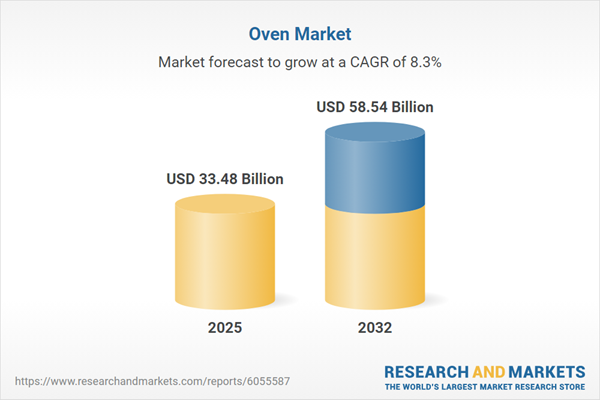Speak directly to the analyst to clarify any post sales queries you may have.
Senior executives evaluating the global oven market face a fast-evolving environment where regulatory changes, digital integration, and shifting user preferences require ongoing strategic adaptation. Staying informed on the latest developments is crucial for driving competitiveness, strengthening market positioning, and optimizing growth.
Oven Market Snapshot
The oven market is demonstrating steady global expansion, moving from USD 31.04 billion in 2024 to USD 33.48 billion in 2025, with an anticipated value of USD 58.54 billion by 2032. This establishes a consistent CAGR of 8.25%, reflecting a market energized by increasing demand for energy-saving and digitally advanced oven solutions. Both commercial and consumer sectors are adopting smarter appliances that leverage connectivity, automation, and enhanced user control. Evolving regulatory policies are catalyzing updates in product designs, with stricter standards for sustainability and performance. As competition intensifies, stakeholders across manufacturing, distribution, and end-use verticals encounter a dynamic landscape with fresh prospects and new complexities in operational practices and procurement strategies.
Scope & Segmentation of the Oven Market
This report provides comprehensive insight into the segments, trends, and stakeholders that shape market direction and guide competitive actions.
- Technology: Convection, conventional, infrared, and microwave ovens represent diverse approaches, each delivering targeted efficiency and supporting a more sophisticated user experience across professional and residential applications.
- Fuel Type: Dual fuel, electric, and gas ovens fit distinct infrastructure scenarios and reflect regional consumer expectations, facilitating broad deployment and installation flexibility.
- Installation Type: Built-in and freestanding models enable buyers to optimize space and meet the evolving requirements of modern facilities and living spaces.
- Capacity: Large, medium, and small ovens serve the operational needs of organizations ranging from industrial settings to smaller commercial venues, enabling workflow alignment and process scalability.
- Functionality: Baking, curing, drying, and roasting functions ensure adaptability, meeting the requirements of food services, manufacturers, and diverse other sectors.
- Distribution Channel: Both offline and online sales channels accommodate evolving buyer journeys, reflecting the increased adoption of digital platforms for research and purchasing.
- Application: Products are tailored for commercial, household, and industrial uses, supporting varied operational and client-focused needs globally across multiple industries.
- Regions: The Americas, Europe, Middle East & Africa, and Asia-Pacific drive unique growth patterns and regulatory developments, each region presenting its own catalysts, demand drivers, and policy landscape for decision-makers to consider.
- Key Players: Leading companies include Bertazzoni, BSH Home Appliances, Dacor, De'Longhi, Electrolux, Faber Group, Fagor Professional, Fisher & Paykel, General Electric, Grieve, Haier, Hawkins Cookers, Hisense UK, ILVE, LG Electronics, Midea India, Miele India, Panasonic, Bosch, Samsung Electronics, Siemens, Smeg, Taikisha USA, Toshiba, Viking Range, Whirlpool, and Wisconsin Oven Corporation.
Key Takeaways for Senior Decision-Makers
- Smart and connected oven technologies are gaining traction, helping brands to enhance operational efficiency and user satisfaction through automation, app-based control, and remote diagnostics.
- Ongoing changes in environmental and efficiency standards are prompting investment in sustainable materials and features to achieve compliance and maintain market relevance.
- Expanding urbanization and demographic shifts are fueling interest in compact, multi-feature ovens designed for constrained spaces and emerging growth markets.
- Enhanced after-sales support, including predictive maintenance and troubleshooting, is now a critical differentiator for customer retention and brand loyalty.
- The rise of e-commerce and direct-to-consumer models is fundamentally altering customer acquisition, necessitating integrated strategies across sales, marketing, and logistics.
- Stronger strategic partnerships and joint ventures are becoming essential, improving local market access and supply chain management amid global industry realignment.
Tariff Impact: Navigating U.S. Policy Changes
Recent developments in U.S. trade policy, particularly the imposition of tariffs on imported oven components, are bringing added volatility to sourcing and pricing. Companies dependent on international suppliers may face increases in both costs and logistical complexity. Senior leaders can respond by evaluating alternative supplier relationships, exploring nearshoring opportunities, and implementing agile procurement processes to sustain supply stability, price competitiveness, and resilience against policy fluctuations.
Methodology & Data Sources
This analysis integrates authoritative secondary research from trusted industry publications and regulatory databases, enriched by executive interviews to ensure relevance and depth. Forecasts are developed through data modeling and scenario planning, supporting risk evaluation and actionable recommendations for strategic planning in the oven market.
Why This Report Matters
- Equips decision-makers with actionable intelligence to spot growth opportunities and improve competitive standing.
- Offers frameworks for managing supply chain, regulatory, and trade risks, supporting more robust investment planning and operational continuity.
- Supplies validated benchmarks and qualitative findings to foster stronger product development and market entry initiatives.
Conclusion
This report empowers industry leaders to anticipate key changes, sharpen strategies, and leverage new opportunities for enduring performance in the evolving oven market.
Table of Contents
3. Executive Summary
4. Market Overview
7. Cumulative Impact of Artificial Intelligence 2025
Companies Mentioned
The companies profiled in this Oven market report include:- Bertazzoni S.p.A.
- BSH Home Appliances Corporation
- Dacor, Inc.
- De'Longhi Appliances S.r.l.
- Electrolux
- Faber Group
- Fagor Professional
- Fisher & Paykel Appliances Ltd.
- General Electric Company
- Grieve Corporation
- Haier Inc.
- Hawkins Cookers Limited
- Hisense UK Limited
- ILVE
- LG Electronics Inc.
- Midea India Private Limited
- Miele India Pvt. Ltd.
- Panasonic Corporation
- Robert Bosch GmbH
- Samsung Electronics Co., Ltd.
- Siemens AG
- Smeg S.p.A.
- Taikisha USA Inc.
- Toshiba Corporation
- Viking Range LLC
- Whirlpool Corporation
- Wisconsin Oven Corporation
Table Information
| Report Attribute | Details |
|---|---|
| No. of Pages | 194 |
| Published | November 2025 |
| Forecast Period | 2025 - 2032 |
| Estimated Market Value ( USD | $ 33.48 Billion |
| Forecasted Market Value ( USD | $ 58.54 Billion |
| Compound Annual Growth Rate | 8.2% |
| Regions Covered | Global |
| No. of Companies Mentioned | 28 |









